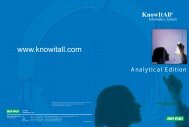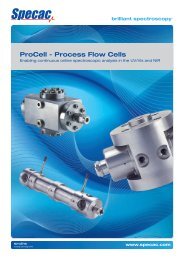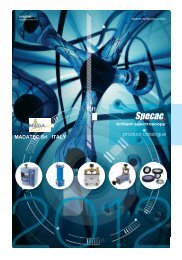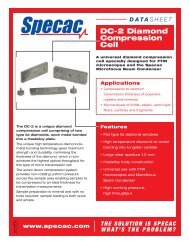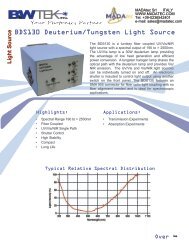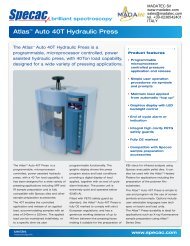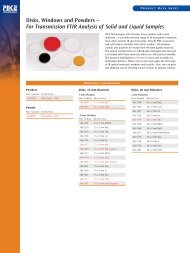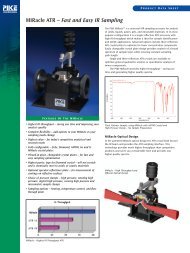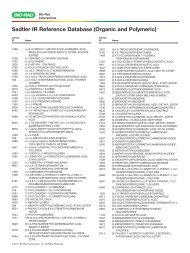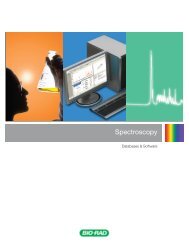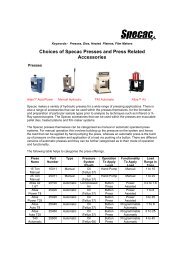Pike Technologies Comprehensive Catalog of FTIR ... - Madatec
Pike Technologies Comprehensive Catalog of FTIR ... - Madatec
Pike Technologies Comprehensive Catalog of FTIR ... - Madatec
Create successful ePaper yourself
Turn your PDF publications into a flip-book with our unique Google optimized e-Paper software.
Transmission Sampling Techniques – Theory and Applications<br />
<strong>FTIR</strong> sampling by transmission is a very popular method for<br />
collection <strong>of</strong> infrared spectra. Its use is easy to explain – the<br />
methods are intuitive and do not require sophisticated sampling<br />
accessories. In many cases, the sample can be placed directly into<br />
the path <strong>of</strong> the infrared beam (with the help <strong>of</strong> sample holder) and<br />
scanned. Further benefits <strong>of</strong> transmission sampling techniques<br />
include compatibility with automated sampling and microsampling<br />
techniques such as IR Microscopy.<br />
Transmission techniques are well documented and have been<br />
successfully used for many years. A large number <strong>of</strong> spectral<br />
libraries contain transmission spectra and are <strong>of</strong>ten used as<br />
references for the purpose <strong>of</strong> qualitative analysis. Transmission<br />
techniques <strong>of</strong>fer many advantages and should be used whenever<br />
possible, unless reliable sample preparation becomes too difficult,<br />
too time consuming or impossible. Transmission is also widely<br />
used for quantitative applications, as significant numbers <strong>of</strong> basic<br />
measurements adhere to the Beer-Lambert law. The law provides<br />
a mathematical relationship between the infrared radiation<br />
absorbed by the sample and the sample concentration:<br />
A = a • b • c<br />
Where:<br />
A = absorbance<br />
a = absorptivity<br />
b = path length<br />
c = sample concentration<br />
The Beer-Lambert law states that absorbance is linearly<br />
proportional to sample concentration (with sample path length<br />
and absorptivity constant). The actual measurements are generated<br />
in percent transmittance (which is not a linear function <strong>of</strong> concentration),<br />
however, they can be converted in real time to<br />
absorbance by all modern <strong>FTIR</strong> instrumentation. As mentioned<br />
before, transmission measurements are intuitive and simple.<br />
However, the majority <strong>of</strong> samples are too thick to be measured<br />
directly and they have to be processed in some way before<br />
meaningful data can be collected. Some <strong>of</strong> the sample preparation<br />
techniques are time consuming and can be destructive. Liquids<br />
and pastes are generally the easiest samples to run. A large<br />
number <strong>of</strong> liquid cells and windows are available for liquid measurements.<br />
Solid samples (with the exception <strong>of</strong> thin films) require<br />
sample preparation – making a pellet (typically potassium bromide –<br />
KBr) or a mull. Gas samples require a suitable gas cell with a<br />
pathlength sufficient to detect the desired component.<br />
Sample Preparation and Analysis<br />
Liquids<br />
Most liquids and dissolved solids are easy to measure by transmission.<br />
Viscous liquids or pastes can be simply pressed between 2 IR<br />
transparent windows and measured by <strong>FTIR</strong>.<br />
<strong>FTIR</strong> Spectrum <strong>of</strong> 1 drop <strong>of</strong> Extra Virgin Olive Oil pressed between<br />
25 mm KBr windows and held in the IR beam using the PIKE Universal<br />
Sample Holder.<br />
Thin liquids or samples in solvent may be best run by using a<br />
demountable liquid cell or a sealed cell, consisting <strong>of</strong> two windows<br />
with a precision spacer in-between. One <strong>of</strong> the windows has two<br />
drilled holes for the introduction and evacuation <strong>of</strong> the sample.<br />
A large number <strong>of</strong> cell options are available – these include<br />
permanently sealed cells, demountable cells with different<br />
window materials and a wide selection <strong>of</strong> spacers.<br />
The pathlength <strong>of</strong> liquid cells can be easily measured with<br />
your <strong>FTIR</strong> spectrometer. Just place the empty cell into the <strong>FTIR</strong><br />
and collect its spectrum. The frequency <strong>of</strong> the sine wave spectrum<br />
(produced by back reflection within the cell) provides the<br />
pathlength using the following equation;<br />
P = (10 • N) / (2 • Δ cm -1 )<br />
Where:<br />
P = pathlength <strong>of</strong> cell in mm<br />
N = number <strong>of</strong> fringes within Δ cm -1<br />
Δ cm -1 = wavenumber range <strong>of</strong> fringe count<br />
It is very important to select compatible IR transparent windows<br />
for your liquid samples. Please refer to the chart on the last page<br />
<strong>of</strong> this note to select your windows. If you still have questions,<br />
please call us.<br />
T RANSMISSION S AMPLING P RODUCTS – A UTOMATED AND M ANUAL T ECHNOLOGIES<br />
95



